kottke.org posts about USA
For the past year, Joanna Goddard has been running a series on her blog called Motherhood Around the World. The goal of the series was to tease out how parenting in other countries is different than parenting in the US. From the introduction to the series:
We spoke to American mothers abroad — versus mothers who were born and bred in those countries — because we wanted to hear how motherhood around the world compared and contrasted with motherhood in America. It can be surprisingly hard to realize what’s unique about your own country (“don’t all kids eat snails?”), and it’s much easier to identify differences as an outsider.
The results, as Goddard states upfront, are not broadly representative of parenting in the different countries but they are fascinating nonetheless. I’ve picked out a few representative bits below. On parenting in Norway:
Both my kids attended Barnehage (Norwegian for “children’s garden”), which is basically Norwegian pre-school and daycare. Most kids here start Barnehage when they’re one year old — it’s subsidized by the government to encourage people to go back to work. You pay $300 a month and your kids can stay from 8am to 5pm. They spend a ton of time outside, mostly playing and exploring nature. At some Barnehage, they only go inside if it’s colder than 14 degrees. They even eat outdoors-with their gloves on! When I was worried about my son being cold, my father-in-law said, “It’s good for him to freeze a little bit on his fingers.” That’s very Norwegian — hard things are good for you.
The Democratic Republic of Congo:
No one thinks twice here about sharing breastmilk. Why let something so valuable go to waste? Not long after my second daughter was born, I went on a work trip to Kenya. I pumped the whole time I was there and couldn’t bear to throw away my breast milk, nor imagine the nightmare scenario of leakage in my luggage. So I saved it all up in the hotel fridge in Ziploc bags. On the day I left, I took all the little bags to the local market and said, “All right, ladies. Who’s got babies and wants breast milk?!” Not a single Kenyan woman at the market thought twice about taking a random white woman’s breast milk. My driver even heard I was handing out milk and asked if I could pump some extra to take home to his new baby.
Abu Dhabi:
There are no car seat or seatbelt laws here. You will regularly see toddlers with their heads peeking out of sunroofs or moms holding their infants in the front seat. The government and the car companies are trying to educate people about the dangers, but the most locals (Emiratis as well as people from countries like India and Egypt) believe that a mother’s arms are the safest place for her child.
India:
In a country in which space comes at such a premium, few parents would dream of allocating a separate room for each child. Co-sleeping is the norm here, regardless of class. Children will usually sleep with their parents or their ayah until they are at least six or seven. An American friend of mine put her son in his own room, and her Indian babysitter was aghast. The young children from middle class Indian families I know also go to sleep whenever their parents do — often as late as 11pm. Our son sleeps in our bed, as well. He has a shoebox of a room in our house where we keep his clothes and crib, and he always starts the night in there, falling asleep around 8pm. That way Chris and I get a few hours to ourselves. Then, around 11pm, Will somehow senses that we are about to fall asleep and calls out to come to our bed. It’s like clockwork, and he falls right back into a deep sleep the second his head hits the pillow.
Australia:
On sleep camps: Government-subsidized programs help parents teach their babies to sleep. I haven’t been to one (though I did consider it when we were in the middle of sleep hell with our daughter) but many of my friends have. The sleep camps are centers, usually attached to a hospital, that are run by nurses. Most mums I know went when their babies were around six or seven months old. You go for five days and four nights, and they put you and your baby on a strict schedule of feeding, napping and sleeping. If you’re really desperate for sleep, you also have the option of having a nurse handle your baby for the whole first night so you can sleep, but after that you spend the next few nights with your baby overnight while the nurses show you what to do. They use controlled crying and other techniques. I have friends who say it saved their lives, friends who left feeling “meh” about the whole thing, and a friend who left after a day because, in her words, “they left my baby in a cupboard to cry.”
Chile:
Giving treats to children is seen as a sign of affection, so strangers will offer candy to kids on the street. I’ll sometimes turn around and a stranger will be handing my daughter a chocolate bar! Several months ago, we were on a bus, and a woman near us was eating cookies. She saw my daughter Mia and said “Oh, let me give you some cookies.” I said, “No, thank you.” But she kept on insisting. Then, a random stranger, who was not even connected to the first woman, chimed in, “You should give your daughter the cookies!” They were very serious about it! I was frustrated at the time, but after the fact I found it funny.
And then more recently, they talked to a group of foreign mothers about how parenting in the US differs from the rest of the world. For one thing, there’s the babyproofing:
Here in the U.S., there is a huge “baby industry,” which does not exist in Romania. There’s special baby food, special baby utensils, special baby safety precautions and special baby furniture. In Romania, children eat with a regular teaspoon and drink from a regular glass. They play with toys that are not specifically made for “brain development from months 3-6.” Also, before I came here, I had never heard of babyproofing! Now I’m constantly worried about my daughter hurting herself, but my mom and friends from home just laugh at me and my obsession that bookshelves might fall.
And the more permissive and involved parenting:
I was surprised that American children as young as one year old learn to say please, thank you, sorry and excuse me. Those things are not actively taught in India. Another difference is how parents here tend to stay away from “because I said so” and actually explain things to their children. It’s admirable the way parents will go into basic reasoning to let the child know why some things are the way they are. When I last visited Bombay, I explained to my then four-year-old about that we couldn’t buy too many things because of weight restrictions in the flight, etc. My relatives were genuinely wondering why I didn’t just stop at “no.”
Like I said, the whole series is fascinating…I could easily see this being a book or documentary (along the lines of Babies).
Update: This series is back after a brief pause with installments on Korea and the Netherlands.
Update: The installment on parenting in Cuba is a good one.
On improvising in the kitchen: We often have to be resourceful and adjust our cooking plans around what we can get. At the moment, it’s been a few months since I’ve seen chicken breasts available at the market, for example. Last year on Thanksgiving, my father-in-law and I spent hours driving around trying to find potatoes, which are a black market item. People will normally walk up to you at the vegetable market and whisper, “I have potatoes.” But, that day there were none. We were like potato junkies trying to get our fix of mashed potatoes for Thanksgiving!
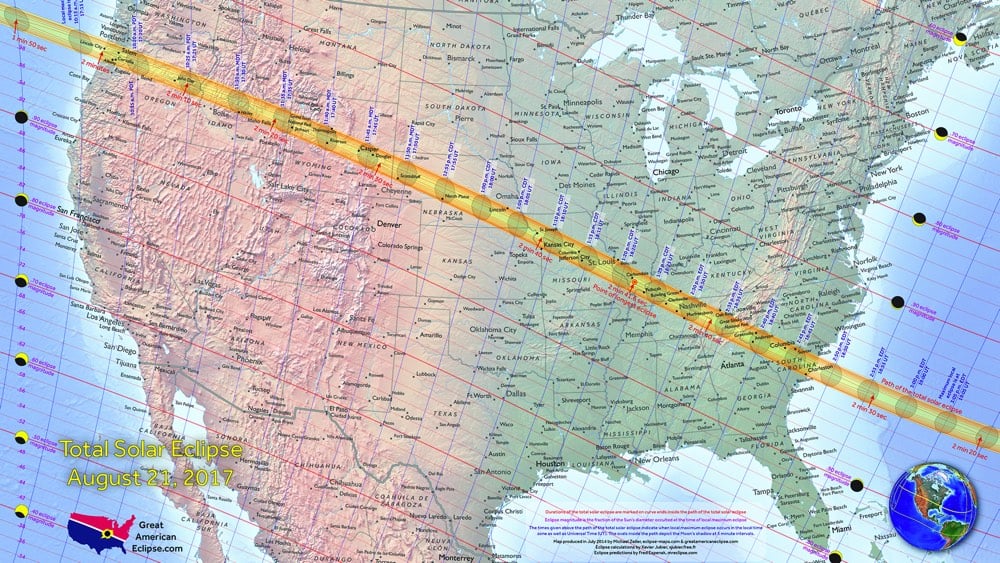
I do not officially have a bucket list1 but if I did have one, watching a total solar eclipse would be on it. Was just talking about it the other day in fact. Well. I am pretty damn excited for the Great American Eclipse of 2017!
In August 21, 2017, millions of people across the United States will see nature’s most wondrous spectacle — a total eclipse of the Sun. It is a scene of unimaginable beauty; the Moon completely blocks the Sun, daytime becomes a deep twilight, and the Sun’s corona shimmers in the darkened sky. This is your guide to understand, prepare for, and view this rare celestial event.
It goes right through the middle of the country too…almost everyone in the lower 48 is within a day’s drive of seeing it. Cities in the path of the totality include Salem, OR, Jackson, WY, Lincoln, NE, St. Louis, MO (nearly), Nashville, TN, and Charleston, SC.
Weather will definitely play a factor in actually seeing the eclipse, so I will be keeping an eye on Eclipser (“Climatology and Maps for the Eclipse Chaser”) as the event draws near. Early analysis indicates Oregon as the best chance for clear skies. Matt, I am hereby laying claim to your guest room in three years time. So excited!!
For the New York Review of Books, Gordon Wood reviews Our Declaration: A Reading of the Declaration of Independence in Defense of Equality by Danielle Allen, a professor at the Institute for Advanced Study. Any review that starts “This is a strange and remarkable book” is worth paying attention to.
This is a strange and remarkable book. There must be dozens of books on the Declaration of Independence written from every conceivable point of view — historical, political, theoretical, philosophical, and textual — but no one has ever written a book on the Declaration quite like this one. If we read the Declaration of Independence slowly and carefully, Danielle Allen believes, then the document can become a basic primer for our democracy. It can be something that all of us — not just scholars and educated elites but common ordinary people — can participate in, and should participate in if we want to be good democratic citizens.
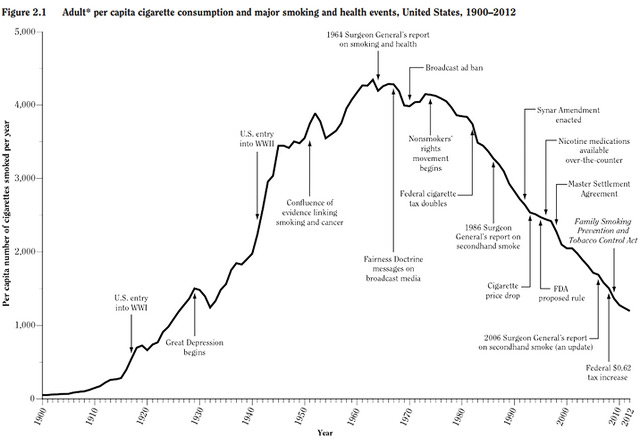
Over the past century, adult per capita cigarette consumption in the US rose from nearly nothing in 1900 to a peak of more than 4000 cigarettes per year in the early 60s and then fell to the current rate of around 1000/yr. Currently, smoking in the US correlates highly with level of education and poverty.
Smoking, as it happens, also appears to be highly correlated with both poverty and education levels in the United States: 27.9 percent of American adults living below the poverty line are smokers, while just 17 percent of those living above it are, according to the CDC; 24.7 percent of American adults without a high school diploma are smokers, while 23.1 percent of those with one are. Only 9.1 percent of those with an undergraduate degree, and 5.9 percent of those with a graduate degree are smokers.
According to Wikipedia, the US is 51st among nations in annual smoking rates. Eastern Europe and Russia hold all the top spots, but their per capita rates (~2800/yr) are all lower than the rate in the US in the 60s. But that’s nothing compared to Scotland…their rate was once 7000 cigarettes per year. (via @dens)
What’s your best guess without looking: How many US states are at least partially north of the southernmost part of Canada?
…
(It’s probably way more than you think.)
…
Ok, I’ll give you two hints…
1. Wyoming is almost *entirely* north of the southernmost point in Canada.
…
2. Part of a state that borders Mexico is north of the southernmost point in Canada.
…
One more big hint: more than 25% of US states are entirely north of Canada’s southernmost point.
So, here’s the answer:

27 US states, more than half, are at least partially north of Canada’s southernmost point. (via @stevenstrogatz)
From the NY Times’ new site, The Upshot, a bunch of maps showing the borders of baseball team fandom, with close-ups of various dividing lines: the Munson-Nixon Line, The Molitor Line, The Reagan-Nixon Line, and the Morgan-Ripken Line.

The NYC and Bay Area maps are so sad…the Mets and A’s get no love. (via @atotalmonet)
American favorites (blue jeans, whiskey, burgers) have been embraced by the Japanese, who have been turning out improved versions of the originals.
In Japan, the ability to perfectly imitate-and even improve upon-the cocktails, cuisine and couture of foreign cultures isn’t limited to American products; there are spectacular French chefs and masterful Neapolitan pizzaioli who are actually Japanese. There’s something about the perspective of the Japanese that allows them to home in on the essential elements of foreign cultures and then perfectly recreate them at home. “What we see in Japan, in a wide range of pursuits, is a focus on mastery,” says Sarah Kovner, who teaches Japanese history at the University of Florida. “It’s true in traditional arts, it’s true of young people who dress up in Harajuku, it’s true of restaurateurs all over Japan.”
It’s easy to dismiss Japanese re-creations of foreign cultures as faddish and derivative-just other versions of the way that, for example, the new American hipster ideal of Brooklyn is clumsily copied everywhere from Paris to Bangkok. But the best examples of Japanese Americana don’t just replicate our culture. They strike out, on their own, into levels of appreciation and refinement rarely found in America. They give us an opportunity to consider our culture as refracted through a foreign and clarifying prism.
Another example, not mentioned in the piece, is coffee. From the WSJ a couple of years ago:
“My boss won’t let me make espressos,” says the barista. “I need a year more, maybe two, before he’s ready to let customers drink my shots undiluted by milk. And I’ll need another whole year of practice after that if I want to be able to froth milk for cappuccinos.”
Only after 18 years as a barista in New York did his boss, the cafe’s owner, feel qualified to return home to show off his coffee-making skills. Now, at Bear Pond’s main branch, he stops making espressos at an early hour each day, claiming that the spike on the power grid after that time precludes drawing the voltage required for optimal pressure.
According to an article in The Journal of the American Medical Association, the obesity rate of American 2- to 5-year-old children has dropped from 14% in 2004 to 8% in 2012.
Children now consume fewer calories from sugary beverages than they did in 1999. More women are breast-feeding, which can lead to a healthier range of weight gain for young children. Federal researchers have also chronicled a drop in overall calories for children in the past decade, down by 7 percent for boys and 4 percent for girls, but health experts said those declines were too small to make much difference.
Barry M. Popkin, a researcher at the University of North Carolina at Chapel Hill who has tracked American food purchases in a large data project, said families with children had been buying lower-calorie foods over the past decade, a pattern he said was unrelated to the economic downturn.
He credited those habits, and changes in the federally funded Special Supplemental Nutrition Program for Women, Infants and Children, for the decline in obesity among young children. The program, which subsidizes food for low-income women, reduced funding for fruit juices, cheese and eggs and increased it for whole fruits and vegetables.
Kevin Drum calls the drop “baffling”.
While they still represent a small overall number, the popularity in the US of naming children after guns (Colt, Remington, Ruger, Gunner, Beretta) is up in recent years.
In 2002, only 194 babies were named Colt, while in 2012 there were 955. Just 185 babies were given the name Remington in 2002, but by 2012 the number had jumped to 666. Perhaps the most surprising of all, however, is a jump in the name Ruger’s (America’s leading firearm manufacturer) from just 23 in 2002 to 118 in 2012. “This name [Ruger] is more evidence of parents’ increasing interest in naming children after firearms,” Wattenberg writes. “Colt, Remington, and Gauge have all soared, and Gunner is much more common than the traditional name Gunnar.”
The death of Philip Seymour Hoffman has turned more attention towards America’s growing heroin problem, where the gateway drug is often a prescription painkiller. From PBS Newshour: “Why more Americans are getting high — and overdosing — on heroin.”
As I mentioned at the time, Vermont Gov. Peter Shumlin devoted his entire State of the State to the “full-blown heroin crisis.”
We are divided by an increasingly wide income gap. Often, this gap can be seen from across a street or park (even if we sometimes try not to look). The NYT takes us for a journey into the world of a homeless girl named Dasani in a multipart piece called Invisible Child:
On the Brooklyn block that is Dasani’s dominion, shoppers can buy a $3 malt liquor in an airless deli where food stamps are traded for cigarettes. Or they can cross the street for a $740 bottle of chardonnay at an industrial wine shop accented with modern art.
Here’s David Simon, creator of The Wire, on the two Americas:
I live in one, on one block in Baltimore that is part of the viable America, the America that is connected to its own economy, where there is a plausible future for the people born into it. About 20 blocks away is another America entirely. It’s astonishing how little we have to do with each other, and yet we are living in such proximity.
Leo Tolstoy probably wasn’t thinking of an American Thanksgiving when he opened Anna Karenina with this line: “Happy families are all alike; every unhappy family is unhappy in its own way.” These days, all families — happy or not — are less alike than ever. In the NYT, Natalie Angier takes a look at the changing definition of family:
Families are more ethnically, racially, religiously and stylistically diverse than half a generation ago — than even half a year ago. In increasing numbers, blacks marry whites, atheists marry Baptists, men marry men and women women, Democrats marry Republicans and start talk shows.
And they’re all coming over to your house for Thanksgiving, which brings us to another quote — this one from Oscar Wilde: “After a good dinner one can forgive anybody, even one’s own relations.”
Buzzfeed asked some Brits to label states on a US map. They didn’t do so well:

My favorite is “Further South Dakota”. In fairness, most US citizens would be hard pressed to name any of the counties of England, much less place them on a map.
Update: See how Americans fared on placing European countries. (Not well.)
You’ve likely seen the various dialect maps of the US…the Coke/soda/pop maps. The Atlantic Video team did a wonderful thing with them…they called native speakers around the country and asked them to pronounce some of the words featured on these maps.
It’s one thing to read the difference between the pronounciations of “route”, it’s another thing entirely to hear them. I haven’t lived in the Midwest since 2000 and I have since transitioned from “pop” to “soda”, “waiting in line” to “waiting on line”, and am working on switching to “sneakers” from “tennis shoes” (or even “tennies”). But I was surprised to learn that I still pronounce “bag” differently than everyone else!
Writing in the Times, Frank Bruni notes the increasing tendency in the US to provide various levels of service for money.
Much has been made of commercial flights these days, with all those divisions between first class and coach. For various supplements or with various deals, you can get a few more inches of legroom or, shy of that, a prime aisle seat. You can get to board earlier or later, and thus hoard or miss out on the overhead bins. Will it be long before there’s a ranked queue for the bathroom? I’m not even sure I’m kidding.
It’s not that pecking orders or badges of affluence are anything new. Our homes, cars, clubs and clothes have long been advertisements of our economic clout, used and perceived that way.
But lately, the places and ways in which Americans are economically segregated and stratified have multiplied, with microclimates of exclusivity popping up everywhere. The plane mirrors the sports arena, the theater, the gym. Is it any wonder that class tensions simmer? In a country of rising income inequality and an economy that’s moved from manufacturing to services, one thing we definitely make in abundance is distinctions.
Reminds me of Tom Junod’s piece in Esquire about waiting in line as an expression of American democracy.
Apparently, an Englishman named Leonard Sim took his family to Disneyland a few years ago, and his vacation was ruined by waiting in line. He invented something called the Flash Pass, and then sold it to an English company called Lo-Q — as in “Low Queue” — which contracted it to Whitewater. So now, when you go to Whitewater and many other American amusement parks, you pay for parking ($15, at Whitewater), and then for admission ($37.50, for any human being over 48 inches tall), and finally for a locker ($16), and then, once you’re inside, you can pay an extra $30 for a “standard” Flash Pass or $40 for the “gold.” And then you can cut the lines.
It sounds like an innovative answer to the problem that everybody faces at an amusement park, and one perfectly in keeping with the approaches currently in place at airports and even on some crowded American highways — perfectly in keeping with the two-tiering of America. You can pay for one level of access, or you can pay for another. If you have the means, you can even pay for freedom. There’s only one problem: Cutting the line is cheating, and everyone knows it. Children know it most acutely, know it in their bones, and so when they’ve been waiting on a line for a half-hour and a family sporting yellow plastic Flash Passes on their wrists walks up and steps in front of them, they can’t help asking why that family has been permitted the privilege of perpetrating what looks like an obvious injustice. And then you have to explain not just that they paid for it but that you haven’t paid enough — that the $100 or so that you’ve ponied up was just enough to teach your children that they are second- or third-class citizens.
This month, Smithsonian magazine tells the story of America using 101 objects drawn from the 19 musuems and research centers of the Smithsonian Institution. Among the objects are the original Star Spangled Banner flag, the passenger pigeon, the polio vaccine, the pill, and Benjamin Franklin’s Experiments and Observations on Electricity.
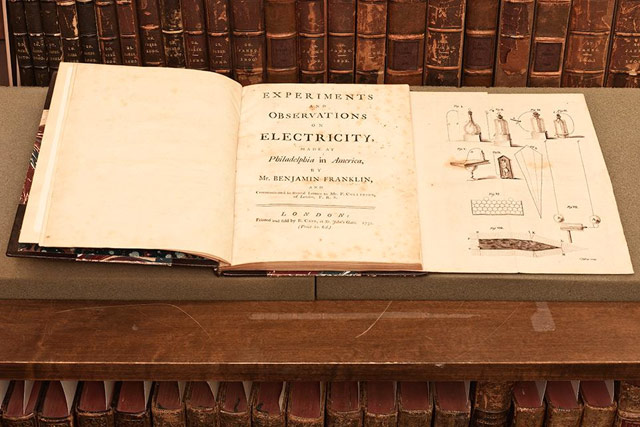
A companion book, The Smithsonian’s History of America in 101 Objects, is available.
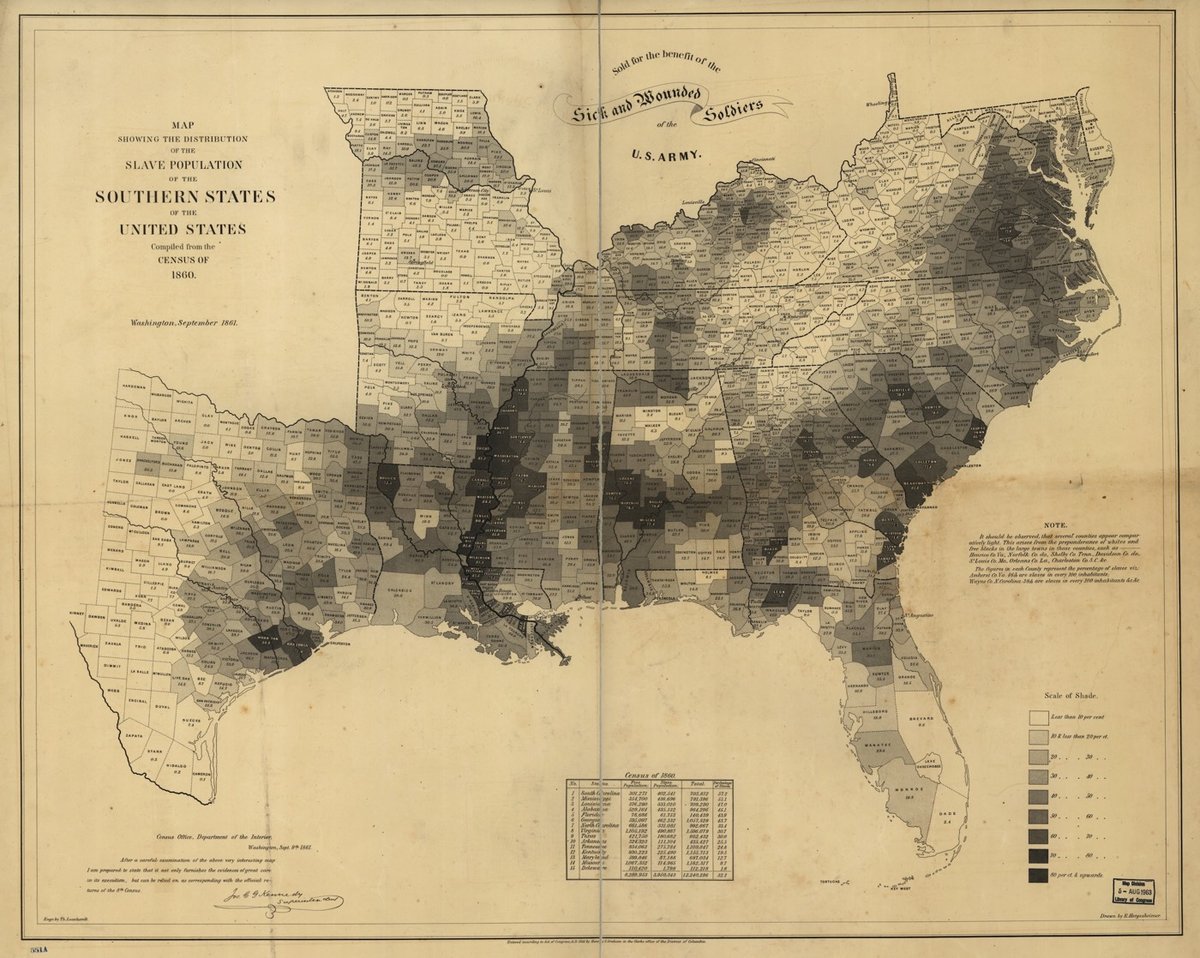
Using data from the 1860 US Census, the Department of the Interior made this map showing the percentages, by county, of the slave population of the southern states.
Though this map was simple, it showed the relationship between states’ commitment to slavery and their enthusiasm about secession, making a visual argument about Confederate motivations.
Schulten writes that President Lincoln referred to this particular map often, using it to understand how the progress of emancipation might affect Union troops on the ground. The map even appears in the familiar Francis Bicknell Carpenter portrait First Reading of the Emancipation Proclamation of President Lincoln, visible leaning against a wall in the lower right-hand corner of the room.
Here’s a larger version. The numbers in some locations are staggering and sickening — in many counties 75% of the population was enslaved and the rate is over 90% in a few places.
For the Journal of the American Revolution, Todd Andrlik compiled a list of the ages of the key participants in the Revolutionary War as of July 4, 1776. Many of them were surprisingly young:
Marquis de Lafayette, 18
James Monroe, 18
Gilbert Stuart, 20
Aaron Burr, 20
Alexander Hamilton, 21
Betsy Ross, 24
James Madison, 25
This is kind of blowing my mind…because of the compression of history, I’d always assumed all these people were around the same age. But in thinking about it, all startups need young people…Hamilton, Lafayette, and Burr were perhaps the Gates, Jobs, and Zuckerberg of the War. Some more ages, just for reference:
Thomas Jefferson, 33
John Adams, 40
Paul Revere, 41
George Washington, 44
Samuel Adams, 53
The oldest prominent participant in the Revolution, by a wide margin, was Benjamin Franklin, who was 70 years old on July 4, 1776. Franklin was a full two generations removed from the likes of Madison and Hamilton. But the oldest participant in the war was Samuel Whittemore, who fought in an early skirmish at the age of 80. I’ll let Wikipedia take it from here:
Whittemore was in his fields when he spotted an approaching British relief brigade under Earl Percy, sent to assist the retreat. Whittemore loaded his musket and ambushed the British from behind a nearby stone wall, killing one soldier. He then drew his dueling pistols and killed a grenadier and mortally wounded a second. By the time Whittemore had fired his third shot, a British detachment reached his position; Whittemore drew his sword and attacked. He was shot in the face, bayoneted thirteen times, and left for dead in a pool of blood. He was found alive, trying to load his musket to fight again. He was taken to Dr. Cotton Tufts of Medford, who perceived no hope for his survival. However, Whittemore lived another 18 years until dying of natural causes at the age of 98.
!!!
Perhaps inspired by All Streets, Ben Fry’s map of all the streets in the US, Nelson Minar built a US map out of all the rivers in the country.
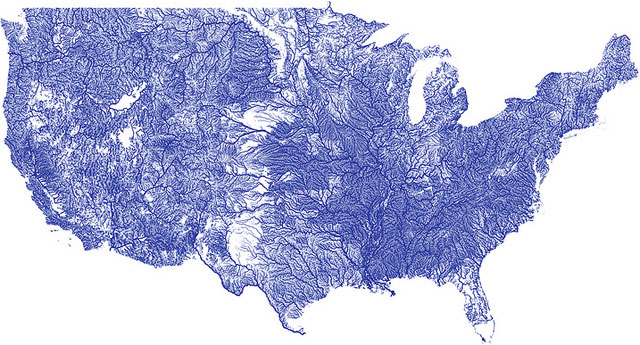

Minar put all the data and files he used up on Github so you can make your own version.
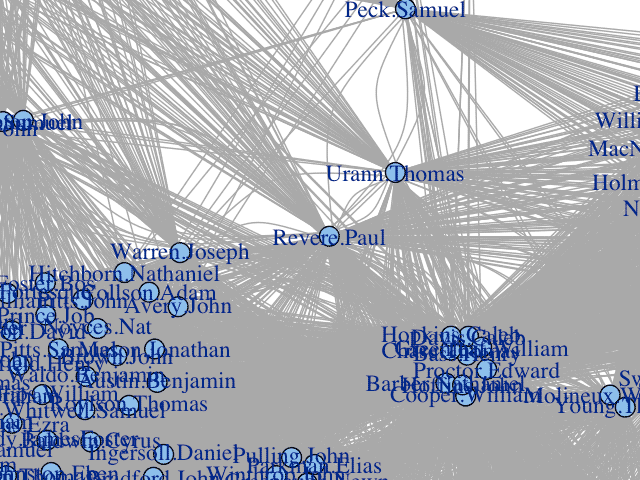
There’s been a lot of discussion recently about government programs like PRISM and how, according to defenders of such surveillance, they “only” collect metadata related to communications and not the content of the communication. In a clever article, Kieran Healy uses only the membership lists of various Boston-area organizations in the late 1770s to find out quite a lot about who might be the leaders of the nascent revolutionary cell. Even with this simple analysis, Paul Revere’s name pops out of the data.
The analytical engine has arranged everyone neatly, picking out clusters of individuals and also showing both peripheral individuals and-more intriguingly-people who seem to bridge various groups in ways that might perhaps be relevant to national security. Look at that person right in the middle there. Zoom in if you wish. He seems to bridge several groups in an unusual (though perhaps not unique) way. His name is Paul Revere.
Once again, I remind you that I know nothing of Mr Revere, or his conversations, or his habits or beliefs, his writings (if he has any) or his personal life. All I know is this bit of metadata, based on membership in some organizations. And yet my analytical engine, on the basis of absolutely the most elementary of operations in Social Networke Analysis, seems to have picked him out of our 254 names as being of unusual interest.
Now, the Crown may have suspected Revere of anti-Royalist leanings without this analysis. But with the analysis, they all but know. Get Revere and a few other highly connected nodes into jail on some trumped-up charges and, voila, maybe the American Revolution never happens or is quickly quashed. Revere and the American Revolution is an extreme example of what Moxie Marlinspike is getting at in We Should All Have Something To Hide: that breaking the law is sometimes how society moves forward.
Over the past year, there have been a number of headline-grabbing legal changes in the US, such as the legalization of marijuana in CO and WA, as well as the legalization of same-sex marriage in a growing number of US states.
As a majority of people in these states apparently favor these changes, advocates for the US democratic process cite these legal victories as examples of how the system can provide real freedoms to those who engage with it through lawful means. And it’s true, the bills did pass.
What’s often overlooked, however, is that these legal victories would probably not have been possible without the ability to break the law.
The state of Minnesota, for instance, legalized same-sex marriage this year, but sodomy laws had effectively made homosexuality itself completely illegal in that state until 2001. Likewise, before the recent changes making marijuana legal for personal use in WA and CO, it was obviously not legal for personal use.
Imagine if there were an alternate dystopian reality where law enforcement was 100% effective, such that any potential law offenders knew they would be immediately identified, apprehended, and jailed. If perfect law enforcement had been a reality in MN, CO, and WA since their founding in the 1850s, it seems quite unlikely that these recent changes would have ever come to pass. How could people have decided that marijuana should be legal, if nobody had ever used it? How could states decide that same sex marriage should be permitted, if nobody had ever seen or participated in a same sex relationship?
What if journalists from foreign countries wrote about the US the way US newspapers and magazines cover events in foreign countries?
On a recent visit to the United States by GlobalPost, signs of the increased security apparatus could be found everywhere.
At all national airports, passengers are now forced to undergo full-body scans before boarding any flights. Small cameras are perched on many street corners, recording the movements and actions of the public. And incessant warnings on public transportation systems encourage citizens to report any “suspicious activity” to authorities.
Several American villagers interviewed for this story said the ubiquitous government marketing campaign called, “If you see something, say something,” does little to make them feel safer and, in fact, only contributes to a growing mistrust among the general population.
“I’ve deleted my Facebook account, stopped using email, or visiting websites that might be considered anti-regime,” a resident of the northern city of Boston, a tough-as-nails town synonymous with rebellion, told GlobalPost. It was in Boston that an American militia first rose up against the British empire. “But my phone? How can I stop using my phone? This has gone too far.”
In a book called Three Felonies A Day, Boston civil rights lawyer Harvey Silverglate says that everyone in the US commits felonies everyday and if the government takes a dislike to you for any reason, they’ll dig in and find a felony you’re guilty of.
The average professional in this country wakes up in the morning, goes to work, comes home, eats dinner, and then goes to sleep, unaware that he or she has likely committed several federal crimes that day. Why? The answer lies in the very nature of modern federal criminal laws, which have exploded in number but also become impossibly broad and vague. In Three Felonies a Day, Harvey A. Silverglate reveals how federal criminal laws have become dangerously disconnected from the English common law tradition and how prosecutors can pin arguable federal crimes on any one of us, for even the most seemingly innocuous behavior. The volume of federal crimes in recent decades has increased well beyond the statute books and into the morass of the Code of Federal Regulations, handing federal prosecutors an additional trove of vague and exceedingly complex and technical prohibitions to stick on their hapless targets. The dangers spelled out in Three Felonies a Day do not apply solely to “white collar criminals,” state and local politicians, and professionals. No social class or profession is safe from this troubling form of social control by the executive branch, and nothing less than the integrity of our constitutional democracy hangs in the balance.
In response to a question about what happens to big company CEOs who refuse to go along with government surveillance requests, John Gilmore offers a case study in what Silverglate is talking about.
We know what happened in the case of QWest before 9/11. They contacted the CEO/Chairman asking to wiretap all the customers. After he consulted with Legal, he refused. As a result, NSA canceled a bunch of unrelated billion dollar contracts that QWest was the top bidder for. And then the DoJ targeted him and prosecuted him and put him in prison for insider trading — on the theory that he knew of anticipated income from secret programs that QWest was planning for the government, while the public didn’t because it was classified and he couldn’t legally tell them, and then he bought or sold QWest stock knowing those things.
This CEO’s name is Joseph P. Nacchio and TODAY he’s still serving a trumped-up 6-year federal prison sentence today for quietly refusing an NSA demand to massively wiretap his customers.
You combine this with the uber-surveillance allegedly being undertaken by the NSA and other governmental agencies and you’ve got a system for more or less automatically accusing any US citizen of a felony. Free society, LOL ROFLcopter.
Update: For the past two years, the Wall Street Journal has been “examining the vastly expanding federal criminal law book and its consequences”. (thx, jesse)
Joshua Katz has been studying American dialects and has made more than 120 maps of some of the differences in American speech. Here are a few examples:
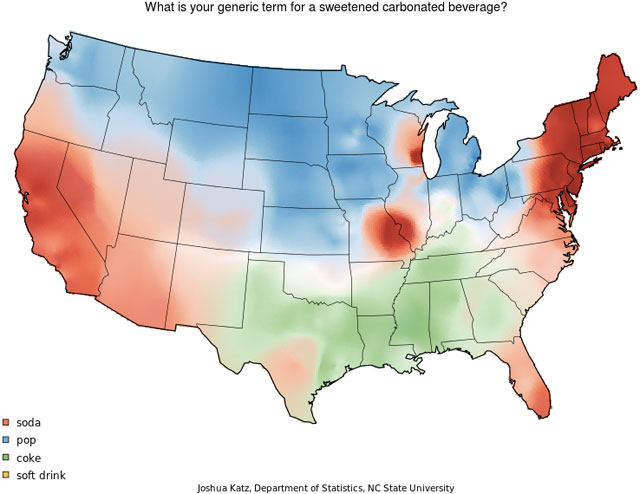

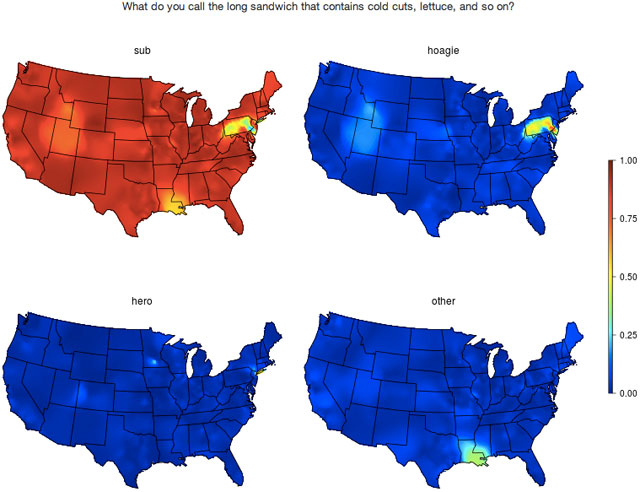
(thx, everyone)
Update: As he notes on the site, Katz’s maps are based on the research and work of Bert Vaux…Vaux’s maps of the same data can be found here. (thx, molly, margaret, & nicholas)
Surprisingly entertaining article about better choices for the state birds of each of the 50 US states.
4. Arkansas. Official state bird: northern mockingbird
Christ. What makes this even less funny is that there are like eight other states with mockingbird as their official bird. I’m convinced that the guy whose job it was to report to the state’s legislature on what the official bird should be forgot until the day it was due and he was in line for a breakfast sandwich at Burger King. In a panic he walked outside and selected the first bird he could find, a dirty mockingbird singing its stupid head off on top of a dumpster.
What it should be: painted bunting
More hilarious science journalism, please. Yes, in addition to the excellent What If? (via @jessamyn)
“Give me your tired, your poor, your huddled masses yearning to breathe free.” And I’ll give them heart disease, high blood pressure, diabetes, and a shorter lifespan. A growing body of research suggests that there is often a high health toll when it comes to coming to America.
A growing body of mortality research on immigrants has shown that the longer they live in this country, the worse their rates of heart disease, high blood pressure and diabetes. And while their American-born children may have more money, they tend to live shorter lives than the parents.
The pattern goes against any notion that moving to America improves every aspect of life. It also demonstrates that at least in terms of health, worries about assimilation for the country’s 11 million illegal immigrants are mistaken. In fact, it is happening all too quickly.
The national rates of gun violence and homicide in the US have fallen significantly in past 20 years, but most people are unaware. From a recently released Pew Research report:
Nearly all the decline in the firearm homicide rate took place in the 1990s; the downward trend stopped in 2001 and resumed slowly in 2007. The victimization rate for other gun crimes plunged in the 1990s, then declined more slowly from 2000 to 2008. The rate appears to be higher in 2011 compared with 2008, but the increase is not statistically significant. Violent non-fatal crime victimization overall also dropped in the 1990s before declining more slowly from 2000 to 2010, then ticked up in 2011.
Despite national attention to the issue of firearm violence, most Americans are unaware that gun crime is lower today than it was two decades ago. According to a new Pew Research Center survey, today 56% of Americans believe gun crime is higher than 20 years ago and only 12% think it is lower.
The whys behind the drop in gun violence (and in crime in general) are more difficult to come by:
There is consensus that demographics played some role: The outsized post-World War II baby boom, which produced a large number of people in the high-crime ages of 15 to 20 in the 1960s and 1970s, helped drive crime up in those years.
A review by the National Academy of Sciences of factors driving recent crime trends (Blumstein and Rosenfeld, 2008) cited a decline in rates in the early 1980s as the young boomers got older, then a flare-up by mid-decade in conjunction with a rising street market for crack cocaine, especially in big cities. It noted recruitment of a younger cohort of drug seller with greater willingness to use guns. By the early 1990s, crack markets withered in part because of lessened demand, and the vibrant national economy made it easier for even low-skilled young people to find jobs rather than get involved in crime.
At the same time, a rising number of people ages 30 and older were incarcerated, due in part to stricter laws, which helped restrain violence among this age group. It is less clear, researchers say, that innovative policing strategies and police crackdowns on use of guns by younger adults played a significant role in reducing crime.
(via hacker news)
A list of the northernmost, southernmost, easternmost and westernmost cities/towns/villages in all 50 US states.
Vermont — Northernmost: Derby Line. Southernmost: Vernon (specifically South Vernon area). Easternmost: Beecher Falls. Westernmost: Chimney Point.
California — Northernmost: Tulelake (note: Fairport is more northerly but is considered a “former settlement”) Southernmost: San Diego (San Ysidro District). Easternmost: Parker Dam. Westernmost: Ferndale.
New York — Northernmost: Rouses Point. Southernmost: Staten Island-New York City (Tottenville Neighborhood) Easternmost: Montauk. Westernmost: Findley Lake.
(via @jessamyn)
US currency is already embarrassing and this new design for the $100 bill is not helping.

This may be worse than the horrible US passport.
After an exhaustive search, I have decided this photo most exemplifies life in these United States during the 1980s:
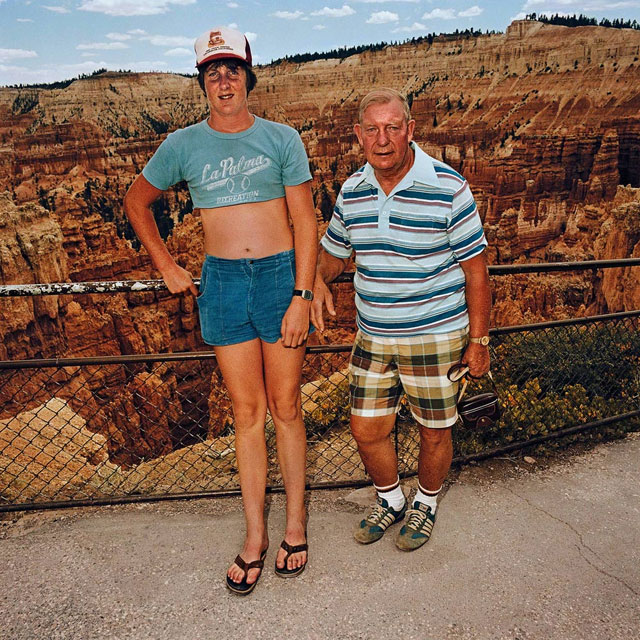
And if not that one, then one of several other possible candidates from Roger Minick’s Sightseer project, for which he took photos of tourists at popular US tourist destinations during the early 1980s and into the 2000s.
When I approached people for a portrait, I tried to make my request clear and to the point, making it clear that I was not trying to sell them anything. I explained that my wife and I were traveling around the country visiting most of the major tourist destinations so that I could photograph the activity of sightseeing. I would quickly add that I hoped the project would have cultural value and might be seen in years to come as a kind of time capsule of what Americans looked like at the end of the Twentieth Century; at which, to my surprise, I would see people often begin to nod their heads as if they knew what I was talking about.
Slate did a feature on this series last week.

If this photo series from 1950 of the interior of the White House being ripped out so that the building could be structurally reinforced isn’t an apt metaphor for the current state of American politics, I don’t know what is.
Experts called the third floor of the White House “an outstanding example of a firetrap.” The result of a federally commissioned report found the mansion’s plumbing “makeshift and unsanitary,” while “the structural deterioration [was] in ‘appalling degree,’ and threatening complete collapse.” The congressional commission on the matter was considering the option of abandoning the structure altogether in favor of a built-from-scratch mansion, but President Truman lobbied for the restoration.
“It perhaps would be more economical from a purely financial standpoint to raze the building and to rebuild completely,” he testified to Congress in February 1949. “In doing so, however, there would be destroyed a building of tremendous historical significance in the growth of the nation.”
So it had to be gutted. Completely. Every piece of the interior, including the walls, had to be removed and put in storage. The outside of the structure-reinforced by new concrete columns-was all that remained.
(via digg)
Newer posts
Older posts





















Stay Connected